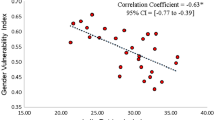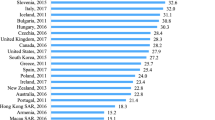Abstract
Wealth inequality between the top and bottom deciles has grown over the last 20 years (Piketty and Zucman in Wealth and inheritance in the long run, Centre for Economic Policy Research, London, 2014), as has the racial wealth gap (Shapiro et al. in The roots of the widening racial wealth gap: explaining the black–white economic divide. Institute on Assets and Social Policy, Brandeis University, Waltham, 2013. http://iasp.brandeis.edu/pdfs/Author/shapiro-thomas-m/racialwealthgapbrief.pdf). Within these broad trends of inequality, some families are able to get ahead and grow their wealth, while others are not. Yet we do not understand well the critical variables that increase the likelihood of wealth mobility across the life course—within the same generation. This paper addresses this gap and investigates the following questions: What accounts for intra-generational relative and absolute wealth mobility for families with children in the first decade of the twenty-first century? And how does it differ by race? The paper draws on two longitudinal data sets—the Panel Study of Income Dynamics household survey data matched with neighborhood-level US Census data (1999–2011), and the IASP Leveraging Mobility (LM) study (1998–2011). Applying an integrated mixed methods design, analyses are conducted in three stages: (1) A grounded theory analytic approach of the LM data determines key variables of wealth mobility: homeownership, income, employment characteristics, extended family wealth, negative life events, and neighborhood factors; (2) regression analyses test these indicators for absolute and relative wealth mobility; and (3) recontextualization through further analyses of LM data deepen the regression results by illustrating the pathways of significant wealth mobility predictors. Results reveal that increasing family income, larger family transfers, consistent long-term homeownership, and in some cases white-collar occupations increase the likelihood of upward relative wealth mobility. Negative life events, higher rates of neighborhood poverty, and black race are negatively correlated with the amount of wealth growth. These key drivers of wealth mobility highlight the need for targeted policies that reinforce and expand opportunities for all families to build wealth over the life course.


Similar content being viewed by others

Notes
Relative economic mobility is typically measured in the movement between quintiles (20 % groups) over time.
Census tracts are designed to be relatively homogeneous units with respect to population characteristics, economic status, and living conditions at the time of establishment; they generally have between 1500 and 8000 people, with an optimum size of 4000 inhabitants. Census tract boundaries normally follow visible features, but may follow governmental unit boundaries and other nonvisible features; they always nest within counties.
All descriptive results are weighted.
We tested the need to use multilevel modeling, due to combining family and neighborhood characteristics. Estimates for the interclass correlation coefficient (Chi square on the group level variance) were lower than .05 and indicate no need for multilevel modeling. In addition, examination of the geographic distribution of families shows that there is little overlap among families residing in the same neighborhood.
References
Austin, A., Hamilton, D., & Darity Jr., W. (2011). Whiter jobs, higher wages: Occupational segregation and the lower wages of black men. EPI briefing paper no. 288. Washington, DC: Economic Policy Institute. Retrieved from http://www.epi.org/publication/whiter_jobs_higher_wages/.
Castro, F. G., & Coe, K. (2007). Traditions and alcohol use: A mixed-methods analysis. Cultural Diversity & Ethnic Minority Psychology, 13(4), 269–284.
Castro, F.G., & Nieri, T. (2008). Culturally-sensitive research: Emerging approaches in theory, measurement and methods for effective research on acculturation, ethnic identity and gender. Paper presented at the Society for Social Work Research, Washington, DC.
Chiteji, N. S., & Hamilton, D. (2002). Family connections and the black–white wealth gap among middle-class families. The Review of Black Political Economy, 301, 8–28.
Chiteji, N. S., & Hamilton, D. (2006). Estimating the effect of race & ethnicity on wealth accumulation & asset-ownership patterns. In J. G. Nembhard & N. Chiteji (Eds.), Wealth accumulation & communities of color in the United States. Ann Arbor, MI: The University of Michigan Press.
Conley, D. (2009). Being black, living in the red: Race, wealth, and social policy in America. Berkeley, CA: University of California Press.
Conley, D., & Glauber, R. (2007). Black–white differences in income and wealth mobility. Paper presented at the Sixth Meeting of the University Working Groups on the Social Dimensions of Inequality.
Conley, D., & Glauber, R. (2008). Wealth mobility and volatility in black and white. Washington, DC: Center for American Progress. Retrieved from https://www.americanprogress.org/issues/economy/report/2008/07/29/4662/wealth-mobility-and-volatility-in-black-and-white/.
Henretta, J. C. (1984). Parental status and child’s home ownership. American Sociological Review, 49(1), 131–140.
Jianakoplos, N. A., & Menchik, P. L. (1997). Wealth mobility. Review of Economics and Statistics, 79(1), 18–31.
Keister, L. A. (2004). Race, family structure, and wealth: The effect of childhood family on adult asset ownership. Sociological Perspectives, 47(2), 161–187.
Keister, L. A. (2007). Upward wealth mobility: Exploring the Roman Catholic advantage. Social Forces, 85(3), 1195–1225.
Keister, L. A., & Moller, S. (2000). Wealth inequality in the United States. Annual Review of Sociology, 26, 63–81.
Kim, H., & Lee, J. (2005). Unequal effects of elders; health problems on wealth depletion across race and ethnicity. Journal of Consumer Affairs, 39(1), 148–172.
Kochhar, R., Fry, R., & Taylor, P. (2011). Wealth gaps rise to record highs between whites, blacks, Hispanics. Washington, DC: Pew Research Center. Retrieved from http://www.pewsocialtrends.org/2011/07/26/wealth-gaps-rise-to-record-highs-between-whites-blacks-hispanics/.
Massey, D., & Denton, N. (1993). American apartheid: Segregation and the making of the underclass. Cambridge: Harvard University Press.
McKernan, S. M., Ratcliffe, C., & Vinopal. (2009). Do assets help families cope with adverse events? Brief 10. Washington, DC: The Urban Insitute. Retrieved from http://www.urban.org/UploadedPDF/411994_help_family_cope.pdf.
McKernan, S. M., Ratcliffe, C., Simms, M., & Zhang, S. (2014). Do racial disparities in private transfers help explain the racial wealth gap? New evidence from longitudinal data. Demography, 51(3), 949–974.
McKernan, S. M., Ratcliffe, C., Steuerle, E., & Zhang, S. (2013). Less than equal: Racial disparities in wealth accumulation. Washington, DC: The Urban Institute. Retrieved from http://www.urban.org/UploadedPDF/412802-Less-Than-Equal-Racial-Disparities-in-Wealth-Accumulation.pdf.
Menchik, P. L., & Jianakoplos, N. A. (1997). Black–white wealth inequality: Is inheritance the reason? Economic Inquiry, 352, 428–442.
Morse, J. M. (1998). Designing funded qualitative research. In N. Denzin & Y. S. Lincoln (Eds.), Strategies of qualitative inquiry (pp. 56–85). Thousand Oaks, CA: Sage Publications.
Nembhard, J., & Chiteji, N. (2006). Wealth accumulation & communities of color in the United States: Current issues. Ann Arbor: University of Michigan Press.
O’Brien, R. L. (2012). Depleting capital: Race, wealth and informal financial assistance. Social Forces, 91(2), 375–395.
Piketty, T., & Zucman, G. (2014). Wealth and inheritance in the long run. London: Centre for Economic Policy Research.
Quadrini, V. (1999). The importance of enterpreneurship for wealth concentration and mobility. Review of Income and Wealth., 45(1), 1–19.
Rank, M. R. (2007). Asset building across the life course. In S. M. Mckernan & M. Sherraden (Eds.), Asset building and low-income families (pp. 67–88). Washington, DC: The Urban Institute Press.
Shapiro, T., Meschede, T., & Osoro, S. (2013). The roots of the widening racial wealth gap: Explaining the black–white economic divide. Waltham, MA: Institue on Assets and Social Policy, Brandeis University. Retrieved from http://iasp.brandeis.edu/pdfs/Author/shapiro-thomas-m/racialwealthgapbrief.pdf.
Shapiro, T., Meschede, T., & Osoro, S. (2014). The widening racial wealth gap: Why wealth is not color blind. In R. Cramer & T. R. W. Shanks (Eds.), The assets perspective: The rise of asset building and its impact on social policy (pp. 99–122). New York: Palgrave Macmillan Publishers.
Sharkey, P. (2013). Stuck in place: Urban neighborhoods and the end of progress toward racial equality. Chicago, IL: The University of Chicago Press.
Steckel, R., & Krishnan, J. (2006). The wealth mobility of men and women during the 1960s and 1970s. Review of Income and Wealth, 52(2), 189–212.
Strauss, A. L., & Corbin, J. M. (1990). Basics of qualitative research: Grounded theory procedures and techniques. Newbury Park, CA: Sage Publications.
Sullivan, L. (2012). A bumpy road: Asset accumulation, unexpected life course events, and later life economic security (Ph.D. in Social Policy). Waltham, MA: Brandeis University. Retrieved from http://gradworks.umi.com/35/62/3562811.html.
The Pew Charitable Trusts. (2012). Pursing the American dream: Economic mobility across generations. Philadelphia, PA: The Pew Charitable Trusts. Retrieved from http://www.pewtrusts.org/~/media/legacy/uploadedfiles/pcs_assets/2012/PursuingAmericanDreampdf.pdf.
The Pew Charitable Trusts. (2013). Moving on up: Why do some Americans leave the bottom of the economic ladder, but not others? Issue brief. Philadelphia, PA: The Pew Charitable Trusts. Retrieved from http://www.pewtrusts.org/~/media/Assets/2013/11/01/MovingOnUppdf.pdf.
Thomas, H., Boguslaw, J., Chaganti, S., Atkinson, A., & Shapiro, T. (2013a). Employment capital: How work builds and protects family wealth and security. Leveraging Mobility Series, No. 2. Waltham, MA: Institue on Assets and Social Policy, Brandeis University. Retrieved from http://iasp.brandeis.edu/pdfs/2013/Employment.pdf.
Thomas, H., Boguslaw, J., Chaganti, S., & Shapiro, T. (2014c). Keeping dreams alive: The lane-changer costs of financial disruptions. Leveraging Mobility Series, No. 3. Waltham, MA: Institute on Assets and Social Policy, Brandeis University. Retrieved from https://iasp.brandeis.edu/pdfs/2014/Lane-Changer.pdf.
Thomas, H., Boguslaw, J., Mann, A., & Shapiro, T. (2013b). Leveraging mobility: Building wealth, security and opportunity for family well-being. Leveraging Mobility Series, No. 1. Waltham, MA: Institute on Assets and Social Policy, Brandeis University. Retrieved from https://iasp.brandeis.edu/pdfs/2013/Overview.pdf.
Thomas, H., Meschede, T., Mann, A., Boguslaw, J., & Shapiro, T. (2014b) Web of wealth: Resiliency and opportunity or driver of inequality. Leveraging Mobility Series No. 4. Waltham, MA: Institute on Assets and Social Policy, Brandeis University. Retrieved from http://iasp.brandeis.edu/pdfs/2014/Web.pdf.
Thomas, H., Meschede, T., Mann, A., Stagg, A., & Shapiro, T. (2014a). Location, location, location: The role neighborhoods play in family wealth and well-being. Leveraging Mobility Series, No. 5. Waltham, MA: Institute on Assets and Social Policy, Brandeis University. Retrieved from https://iasp.brandeis.edu/pdfs/2014/Location.pdf.
Weller, C., & Fields, J. (2011). The black and white labor gap in America: Why African Americans struggle to find jobs and remain employed compared to whites, Issue brief. Washington, DC: Center for American Progress. Retrieved from https://www.americanprogress.org/issues/labor/report/2011/07/25/9992/the-black-and-white-labor-gap-in-america/.
Author information
Authors and Affiliations
Corresponding author
Rights and permissions
About this article
Cite this article
Meschede, T., Thomas, H., Mann, A. et al. Wealth Mobility of Families Raising Children in the Twenty-First Century. Race Soc Probl 8, 77–92 (2016). https://doi.org/10.1007/s12552-016-9161-1
Published:
Issue Date:
DOI: https://doi.org/10.1007/s12552-016-9161-1



